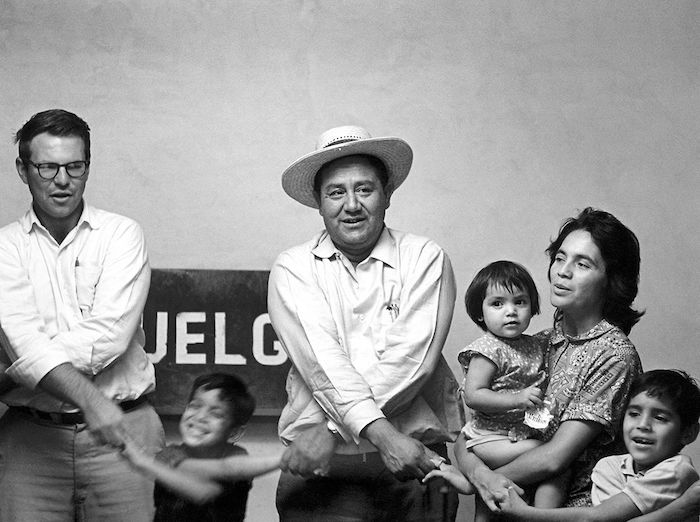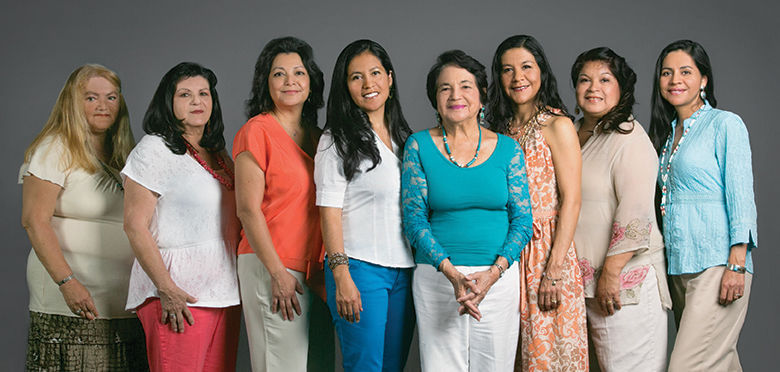“Can you be fully committed to changing the world and change diapers at the same time?” - Frida Berrigan, It Runs in the Family: On Being Raised by Radicals and Growing into Rebellious Motherhood
“¡Sí Se Puede!” - Dolores Huerta
I.
As a teacher, it’s rare to be moved by a homework assignment. Disappointed, intrigued, irked maybe. But rarely moved.
Before each class, I scroll through my students’ online homework looking for insightful or provocative bits for that day’s discussion. But the exercise of grading these assignments is (I confess) rather routine, dispassionate. Credit. No credit.
This student’s response did not feel routine, though. This one struck a nerve:
Although Latinos and brown people went through enormous discrimination and racism, it is shrugged off in our textbooks and in lectures by our professors. Being that I am Latino, I have a unique perspective about the movement and the aftermath, and even the Latino community isn't [as] educated on the subject as they should [be]. No one praises Cesar Chavez on the level they praise Malcolm X, MLK or Rosa Parks.
I had asked my students to reflect on a documentary titled Chicano!, a four-part series that dives deep into the robust and varied Mexican American activism of the 1960s and ‘70s. On a college campus that is about 50% Latinx, this understudied history has an added resonance.
Over the past few years, I’ve witnessed my students’ anger, disbelief, and sadness at anti-Mexican remarks by first the Republican candidate, and then the current president, Donald Trump. I’ve taught CAMP scholars who have labored with their families in the fields of this country. I’ve read students’ oral history interviews with grandparents who walked three miles to a segregated school each day because, as Mexican Americans, they could not attend the public school down the street. I’ve listened to one of my brightest students, born in Honduras but a U.S. resident since age 5, tell the story of how he first discovered that he was undocumented: he wanted to apply for an after school job in high school, only to learn from his parents that he did not have a social security card.
…
In our U.S. history class, we think critically about the stories we tell or don’t tell about the nation’s past. We consider who does the telling of history, and the relationship between a people’s history and their power.
The Chicana activist Dolores Huerta was literally written out of history: in 2010, the Texas Board of Education removed her name from our state’s K-12 history curriculum, apparently because she made a critical remark about the Republican Party in a speech.
Even when Huerta has been acknowledged in the historical record, it’s often as a subordinate, a sidekick, to César Chávez. Huerta, however, co-created the United Farm Workers alongside Chávez; they were partners from its inception in 1962.**
It was also Huerta who coined the slogan “Si, se puede,” the iconic rallying cry of the farmworkers’ movement. It has often been misattributed to Chávez, even by former President Barack Obama, who borrowed the slogan “Yes, we can” for his 2008 campaign.*
…
Maybe all of this is just prologue to say: Fabian, this one’s for you.
II.
Huerta with children at the United Farm Workers Hall, 1960s.
Huerta was born in New Mexico in 1930 but moved at age 3 to Stockton, California. Even though Huerta was raised by a single mom who was a savvy business woman, she still grew up in a post-war, Catholic context where the imperative for women was to marry and make babies.
So, she did. Huerta met her first husband Ralph Head in high school, and they had two daughters, Celeste and Lori, before divorcing. In the early 1950s, she married fellow activist Ventura Huerta, and they had five more children together.
But Huerta quickly realized she wanted something more than the prescribed roles of wife and mother. Briefly a school teacher, she realized that she could better serve the hungry farm children in her classrooms by organizing their parents.
Huerta’s first experiences as an activist were, however, largely in urban settings. In the 1950s, she joined the Stockton chapter of the Community Service Organization (CSO), where she led voter registration drives and fought for economic rights for Latinos. When the CSO decided not to support a farm workers’ strike, Chávez approached Huerta about starting their own organization.
Huerta experienced the decision to go to Delano and represent the farm workers as “a calling.” But this strong sense of vocation also entailed uprooting her family from Stockton to the San Joaquin Valley. It also involved leaving a couple of her younger children behind in Stockton.
“They had no choice,” Huerta later recalled. “I was doing something I wanted to do.”
III.
The 2017 documentary Dolores explores the tensions between Huerta’s activism and motherhood.
In the wake of the 1965 Delano strike, Huerta was lead negotiator on a contract with Schenley Wine Company, the first of its kind between workers and agribusiness. In 1970, her work on the nationwide grape boycott brought an entire industry – the table-grape growers of California – to the bargaining table.
Huerta at negotiations with Gallo, circa 1973. Via Smithsonian.
As Huerta traveled the country, she received personal attacks, even from within her own community, for ‘abandoning’ her family. She was subject to heightened scrutiny after she started a romantic relationship with Chávez’s brother Richard, whom she never married but with whom she had four additional children.***
But the more difficult piece to watch was how Huerta’s absences and the ad hoc living arrangements clearly affected her kids. They resented being deprived of the creature comforts and air of normalcy that were incompatible with their mother’s activism.
Aside from material possessions, they felt deprived of her attention. Her son Emilio noted that, due to Huerta’s long absences, it took months for her to find out that he’d dropped out of high school. Daughter Maria Elena lived with another family for a few years while her mother was orchestrating the grape boycott in New York; she didn’t want to leave at first because there was at least a semblance of stability in that temporary home.
It must have felt, as one of her grown children noted, not without some bitterness, that “The movement became her most important child.”
In another sense, of course, Huerta’s activism and her love for her children complemented and reinforced each other. The farm workers’ movement was a labor movement but also a social one, a catalyst for an emerging wave of Brown Pride. Huerta might not have grown up in a migrant family, but she could connect deeply to the dispossession and disavowal that Latinos felt in the U.S. One of her brothers was beaten by police for wearing a zoot suit in the 1940s, and Huerta herself found that “no matter what I did, I could never be an American.”
While mainstream media sent the message that brown was ugly, inferior, or unwanted, Huerta’s kids were raised in an empowering counterculture. As one of Huerta’s daughter recalls, “our mother was constantly telling us how beautiful our dark skin was.”
Huerta with her daughters, early 2010s.
IV.
Learning about Huerta’s story gives new life to the tired question ‘Can women have it all?’ Because her example demands that we move beyond the individual to think about community. To take the onus off of the woman alone, isolated in her nuclear-family box, and consider instead how we might all do better in raising our children and supporting each other to engage in meaningful work.
I love Huerta’s pragmatic response after watching the documentary of her own life:
Her takeaway from the biopic was not, ‘wow, that was hard on me to be devoted to the movement and raise a large family.’ Ever the activist, she asked instead, ‘what can we do collectively to make it less hard for other parents?’
…
I titled this post “trade-offs” because Huerta’s life clearly involved difficult choices, great risk-taking, and greater sacrifices. As she acknowledges in Dolores:
Not every woman is going to take the kinds of risks that I did with my children….it still pains me when I think about it.
But Huerta sacrificed while remaining uncompromising in her vision for the movement, and for her life’s work. As a young mother in the 1950s, Huerta undertook a quest for meaning, and committed to a larger purpose than herself. And she hoped to impart those values to her children: “I’m trying to educate my children…to give their lives to other people.”
Huerta’s rejection of individualism and above all apathy might help us reevaluate how we define “having it all” in 2019.
Why do we limit our imaginings to a cold calculus of motherhood + personal fulfillment in a career? Where do empathy, civic engagement, and global awareness fit into this narrow vision of a successful life?
Huerta’s notion of “having it all” redefines “all” not as a set of possessions or accomplishments. Instead, it infuses the phrase with the spirit of “having for all”: seeking physical safety, financial security, and social freedom not just for oneself and one’s own children but for everyone.
Huerta holding up a sign that reads “Strike,” 1960s.
V.
Asked which career path she would have chosen if not for her activism, Huerta responds that she might have been a dancer. She explains,
I had a passion to be a dancer but decided I liked people better than dance or music.
So, the activist and scholar Angela Davis describes Dolores Huerta as “a dancer on the stage of justice.”
Now in her late 80s, Huerta is still at it, knocking on doors, registering voters, addressing young Latinas at schools and conferences. Witnessing the spectacle of her energy and endurance shuts down any excuses you might have: too tired, too busy, too old.
There is something about Huerta’s presence that beckons my wallflower self to peel herself away from the anonymity and comfort of the sidelines. To take those first tentative steps onto the gymnasium floor, and join the dance.
ACTION
Join me in donating to the Dolores Huerta Foundation for Community Organizing. Their mission is “to create a network of organized healthy communities pursuing social justice through systemic and structural transformation.”
NOTES
*Obama later acknowledged this indebtedness when awarding Huerta the Presidential Medal of Freedom in 2012.
**originally called the National Farm Workers Association (NFWA)
***The UFW itself was not immune to chauvinism. Although, in the 1960s, it had more female members than all other unions in the U.S. combined, Huerta was the only woman on its executive board. After Chávez’s death in 1993, Huerta was not elected to replace him as president, despite co-founding the organization and devoting decades of her life to the union.



